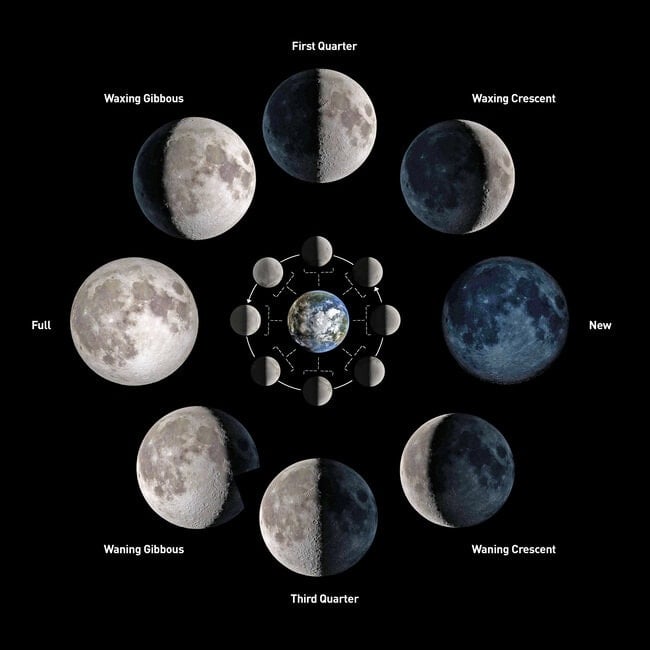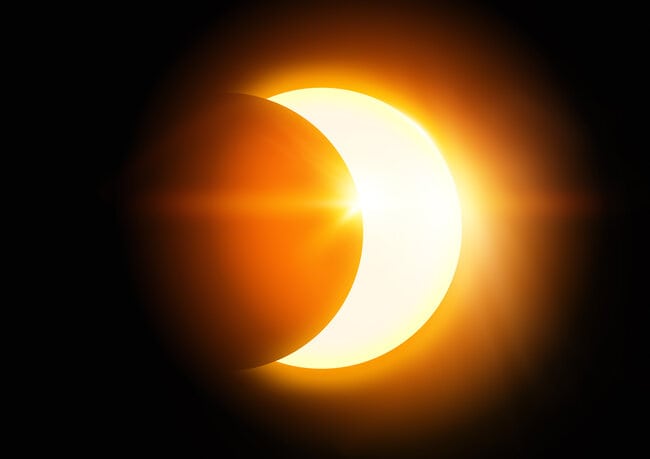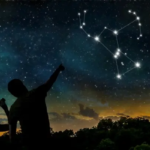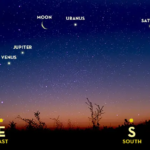When Is The Next New Moon 2025?

The next new Moon occurs on December 19, 2025 at 8:43 p.m. EST (5:43 p.m. PST). Not to be confused with a full Moon, a new Moon is usually impossible to see because it is drowned out by the Sun’s bright light during the day. (However there are some exceptions.) Learn about this unique lunar phase and why it’s an ideal time for stargazing! Plan your next starry camping trip or break out your telescope using our New Moon 2025 Calendar here. Also, if you love crescent Moons, you’ve got to see our Crescent Moon Calendar.
What Is A New Moon?
A new Moon occurs when the Moon comes between the Earth and Sun, which usually happens once a month. If these celestial bodies are perfectly aligned, a solar eclipse takes place. See when the next eclipse will occur.
A new Moon marks the end of one lunar cycle and the beginning of the next. For instance, when the Full Harvest Moon wanes and finally becomes a new Moon (about two weeks later), the Hunter’s Moon cycle begins and waxes until the next full Moon occurs (about another two weeks later). Any questions? Ask us in the comments!
The Buzz About “Black Moon”
You may have heard people on social media calling the new Moon from August 2025 the “Black Moon,” but this is not an Almanac term. A Black Moon by the Almanac’s definition is an alternative name for February’s Moon when there aren’t enough days in the month to ripen and become a Full Snow Moon.
Actually, the Almanac’s ancient “Book of Answers” refers to the second new Moon of a month or the third new Moon of a season (when there are four within any season) as a Green Moon! However, if you are interested in learning more about the so-called “Black” Moon, we invite you to check out this article from our friends at EarthSky.org.
New Moon 2025 Dates And Times
Although seeing a big, bold, beautiful Moon light up the night sky may be breathtaking, all of that lunar light also washes out the light of the stars. If you want to see the most stars at night, stargaze around the time of a new Moon. The darkest skies of each month—the times you can see the fainter stars and constellations—is a few nights before and after the new Moon. After reviewing the calendars here, see our Best Days for Stargazing.
|
New Moon 2025 Calendar
|
||
|---|---|---|
| New Moon Date | Native American Name | Eastern Time |
| January 29 | New Snow Moon | 7:35 AM |
| February 27 | New Worm Moon | 7:44 PM |
| March 29 | New Pink Moon | 6:57 AM |
| April 27 | New Flower Moon | 3:31 PM |
| May 26 | New Strawberry Moon | 11:02 PM |
| June 25 | New Buck Moon | 6:31 AM |
| July 24 | New Sturgeon Moon | 3:11 PM |
| August 23 | New Corn Moon | 2:06 AM |
| September 21 | New Harvest Moon | 3:54 PM |
| October 21 | New Beaver Moon | 8:25 AM |
| November 20 | New Cold Moon | 1:47 AM |
| December 19 | New Wolf Moon | 8:43 PM |
Note: Times listed are Eastern Standard (or Eastern Daylight when appropriate).
|
New Moon 2026 Calendar
|
||
|---|---|---|
| New Moon Date | Native American Name | Eastern Time |
| January 18 | New Snow Moon | 2:52 PM |
| February 17 | New Worm Moon | 7:01 AM |
| March 18 | New Pink Moon | 9:23 PM |
| April 17 | New Flower Moon | 7:52 AM |
| May 16 | New Blue Moon | 4:01 PM |
| June 14 | New Strawberry Moon | 10:54 PM |
| July 14 | New Buck Moon | 5:44 AM |
| August 12 | New Sturgeon Moon | 1:37 PM |
| September 10 | New Harvest Moon | 11:27 PM |
| October 10 | New Hunter’s Moon | 11:50 AM |
| November 9 | New Beaver Moon | 2:02 AM |
| December 8 | New Cold Moon | 7:52 PM |
Lunar Names
It is a Farmers’ Almanac tradition to call out the historical names for each Moon over the course of the year. For instance, June’s Strawberry Moon. Typically these names are associated with the “full” phase—when the Moon is brightest and most apparent in the sky—but these names are actually ascribed approximately two weeks prior, upon each new Moon. We included these names in the calendars above so you may anticipate them as they grow into beautiful brightness!
Any questions? Contact [email protected]
A Lunar Month Or “Moonth”
Ancient civilizations around the world often used the lunar phases as a calendar. They would mark the passing of time by lunar months or “moonths.” Similar to the length of a month (approximately four weeks), a lunar month is the period of time it takes for the lunar cycle to repeat–roughly 29.5 days.
The most common start to a lunar month is the “new” phase. However this name once had a different meaning. In the ancient sense, it referred the first moment that the Moon could be observed (after being completely invisible in the sky) as it emerged in a waning crescent stage, appearing to be reborn in light.
Stargazers would witness the slimmest crescent hanging in the twilight of the western sky and call it “new,” but this sight actually occurs approximately 12-24 hours after the point that astronomers would consider to be “new” today.
Once a crescent was sighted, the new month would begin. The timing of annual religious holidays including Lunar New Year, Ramadan, Easter, and Rosh Hashanah are linked to accurately identifying lunar phases. After centuries of such observations, ancient cultures could then calculate the timing without having to see it. If their predictions were accurate enough, they could even forecast the most dramatic of astronomical events: a total solar eclipse! (Solar eclipses only happen during a “new” phase.)

When Is A New Moon Visible?
A new Moon may become visible – very, very rarely — in the event of a solar eclipse. During these times, it comes precisely between Earth and the Sun. When the Moon blocks a portion of the Sun (looking like a monster took a bite of the solar disc) this is called a partial solar eclipse.

When the Moon slides in front of and obscures the entire Sun, that is a total solar eclipse. These events only occur during a “new” phase. As a general rule, three days before and after, a crescent Moon becomes visible.
Crescent Moon Calendar 2025
Do you love looking up at the sky and seeing a beautiful crescent Moon? Here are some of the best days, times, and directions to look:
|
Crescent Moon Calendar 2025
|
||
|---|---|---|
| Dates | Time | Direction |
| January 2, 3, 4 | 1-2 hours after sunset | West |
| January 24, 25, 26 | 1-2 hours before sunrise | East |
| February 1, 2, 3 | 1-2 hours after sunset | West |
| February 22, 23, 24 | 1-2 hours before sunrise | East |
| March 2, 3, 4 | 1-2 hours after sunset | West |
| March 24, 25, 26 | 1-2 hours before sunrise | East |
| April 1, 2, 3 | 1-2 hours after sunset | West |
| April 22, 23, 24 | 1-2 hours before sunrise | East |
| April 30, May 1, 2 | 1-2 hours after sunset | West |
| May 21, 22, 23 | 1-2 hours before sunrise | East |
| May 29, 30, 31 | 1-2 hours after sunset | West |
| June 20, 21, 22 | 1-2 hours before sunrise | East |
| June 28, 29, 30 | 1-2 hours after sunset | West |
| July 19, 20, 21 | 1-2 hours before sunrise | East |
| July 27, 28, 29 | 1-2 hours after sunset | West |
| August 18, 19, 20 | 1-2 hours before sunrise | East |
| August 26, 27, 28 | 1-2 hours after sunset | West |
| September 16, 17, 18 | 1-2 hours before sunrise | East |
| September 24, 25, 26 | 1-2 hours after sunset | West |
| October 16, 17, 18 | 1-2 hours before sunrise | East |
| October 24, 25, 26 | 1-2 hours after sunset | West |
| November 15, 16, 17 | 1-2 hours before sunrise | East |
| November 23, 24, 25 | 1-2 hours after sunset | West |
| December 14, 15, 16 | 1-2 hours before sunrise | East |
| December 22, 23, 24 | 1-2 hours after sunset | West |

Dean Regas
Dean Regas is an astronomer and author of seven books including 100 Things to See in the Night Sky and How to Teach Grown-Ups About Pluto and host of the popular astronomy podcast Looking Up with Dean Regas. He can be reached at: www.astrodean.com






You say that the new moon is impossible to see because the sky is flooded with the light of the sun. My understanding of a new moon is that it is at night when the moon has risen and is not “visible, ” or is dark, because the sun. As a kid I marveled at this phenomenon.
He right, its not that the moon has not risen yet. It’s just the visible side of the moon is just facing away from earth as it do not rotate like the earth so one side is always facing the earth.